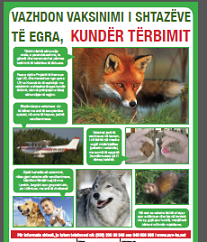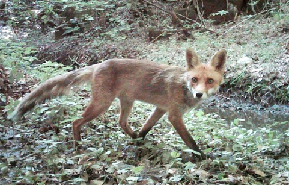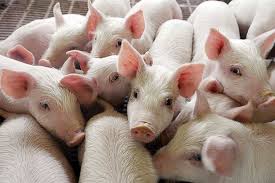| |
Oral rabies vaccine distribution | |
|
The ORV bait which has been developed has an attractive taste and smell for carnivores. This can either be distributed in suitable habitats for foxes by hand but, on a large scale, it is much more effective to distribute the baits over suitable areas by fixed wing aeroplanes. This technique has been used successfully in many countries and is now used as the main method of wildlife vaccination against rabies in Kosovo. ORV distribution is done twice yearly, in Spring and Autumn (250,000 baits at each distribution, 25 baits per square kilometre). It has been done now for five years in Kosovo and will continue for a further year. By then, providing similar activities are being undertaken in the neighbouring countries, there should be no hazard from rabies in the wildlife population.
It is the duty of the project to monitor the ORV distribution campaigns and ensure that they are undertaken correctly. To achieve this, together with staff from FVA, the following is undertaken:
Take a sample of vaccine when it arrives in Kosovo and send it to a rabies world reference laboratory to test its titre to ensure that it is an effective vaccine.
Monitor transport and storage of the vaccine up to the point of dispersal to ensure that it is maintained at required temperature in conditions that will not adversely affect its stability and efficacy.
Report back to FVA and EU on the performance of the ORV dispersal.
The project which ends in February 2016 has only one more ORV programme to deliver in its budget. It has been shown conclusively that the Autumn ORV is much more successful than the Spring ORV in raising the immunity against rabies in the fox population. This is because of the very rapid turnover in the population, the average lifespan of a wild fox in Kosovo being only between one and two years. In the Spring, the new generation is still in the dens where the cubs are reared and too young to go out and forage and get exposed to the baits. It was decided, therefore, to postpone the final ORV campaign to the Autumn of 2015. Thus, there has been no Spring campaign this year.
There will be the usual Public Information Campaign preceding the Autumn ORV. | |
|
Public Information Campaign | |
|
Before an ORV campaign takes place, it is important to make the general public in Kosovë aware of what will happen so that they know how to respond to finding ORV baits dropped from aircraft. They also need to know of the reasons for undertaking an ORV campaign and, therefore, they should be aware of the severe danger to them if rabies is allowed to infect humans or their domestic pets (dogs and cats). To address these concerns, the project regularly, and at least before every ORV dispersal and on 28 September (Rabies World Day), undertakes public information campaigns (PICs).
These involve production of leaflets and posters informing the public on the dangers of rabies and, before each ORV dispersal, the public are alerted through radio and TV broadcasts and adverts in national newspapers in Albanian and Serbian. Also informed are staff of FVA, Ministry of Agriculture, Forestry and Rural Development (MAFRD), Ministry of Health, Ministry of Education, University of Prishtinë, Municipal Authorities and Police. |
 |
|
ORV Bait Uptake Trial | |
| |
The ORV bait uptake trial involves placing by hand ORV baits at sites accessible by wildlife, marking the sites and returning to the sites at least three times over the following three days to record whether the bait has been taken. The purpose of the trial to record consumption of vaccine baits by wild animals is to evaluate the performance and efficiency of ORV distribution.
ORV bait uptake trials have taken place regularly since May 2013 after each Spring and Autumn ORV dispersal campaign at several sites. Bait uptake at the last trial (Spring 2014) varied from 58% to 90% with a meant bait uptake of 79%.
The following links show a fox and a marten taking the ORV baits
Fox
Marten
A full update of the ORV Bait Uptake Trials up to the end of 2014, and a report on ORV analysis - bait contact (tetracycline testing) and immune status (ELISA tests) of foxes tested, can be seen in the Documents file.
|

Bait uptake trial activities
|
|
Wildlife Surveillance | |
| |
At the start of the DCE Projects, little was known about the numbers and distributions of the potential wildlife hosts for rabies (foxes and other wild carnivores) and CSF (wild boars) in Kosovo so activities have included study of these wildlife populations.
Motion activated cameras are being used extensively to monitor wildlife, principally for foxes and wild boar, initially in Blinaja hunting reserve. Other sites for the cameras have included regional garbage dumps which are assumed could be meeting points between wild carnivores, particularly foxes which are a potential reservoir for rabies, and stray and domestic dogs which are a particular danger to man if they become infected with rabies. These interactions have been recorded at a garbage site near Prizren.
Cameras sited near Shtime recorded pictures of other wild carnivores (wild cats and badgers) as well as foxes.
Cameras were placed to overlook sites for monitoring ORV bait uptake and martens were pictured eating the baits at Izhance (Shtprce), Germia, Radoniqi Lake and a fox eating the baits Reqak (Shtime), Badovc lake .
More recently, cameras have been placed in Malishevë, Ferizaj, Kamenicë, Dubocak, Pristinë and Dragash and images and short videos of a wide variety of wildlife have been captured, in addition to those described previously, bear, wolves, wild boars, roe deer and hares. Foxes and martens regularly appear and, only recently, wild boar in four locations.
The abundance and variety of wildlife observed in this study has been suprising and gratifying to those who appreciate wildlife in the environment and consider that opportunities for tourism in Kosovo’s rural areas are enhanced by their presence.
The work with camera traps should continue after the end of this project through the Kosovo Forest Agency and the FVA as staff of both organisations have been trained in their use and additional cameras are being purchased by the project to provide continuity and sustainability of this work.
Analysis of the data from the cameras is being undertaken by the Project Field Officer and Epidemiologist who have been supported by a consultancy by a wildlife expert from Animal and Plant Health Authority, UK, Sarah Beatham. The report on her consultancy can be seen in the Documents File.
|
|
|
Disease Surveillance | |
|
Wildlife | |
| |
Wildlife samples are being collected from wild carnivores, mostly foxes, for testing for rabies antigen, indicating infection, and rabies antibodies, indicating successful vaccination. Samples of long bone are also tested for tetracycline, a marker put in the bait, so that, if found, it can show exposure to the bait, even if no immune response has been evoked.
Through MAFRD and KFA, licensed hunting associations have been approached, their hunters have been trained in sample collection, and wildlife they have shot are collected or sampled, processed by the project and material is forwarded to the KVL for testing for rabies and CSF, whichever is appropriate.
Data on wildlife samples are stored in the InterTrace database for analysis and locations from where animals were sampled are mapped and displayed in Google maps and Google Earth.
Mapping by species.
Biomarker / tetracycline test results.
ELISA test results.
Mapping by regions.
Mapping by estimated age of animals.
Mapping by circumstance of observation (hunted, road killed, found dead)
|
|
| |
Sampling kits have been prepared and distributed to licensed hunters. Samples are being tested in Kosovë Veterinary Laboratory (KVL) .
In total, 659 samples from wild carnivores had been received for rabies testing by 31/12/2014.
The number of wild boar samples received for CSF testing by 31/12/2014 is 40.
While the number of samples for rabies testing is satisfactory, the numbers for CSF testing are too low. According to hunters this is because, due to previous hunting activity, numbers of wild boar in Kosovë are low. This has been supported by evidence from the work with movement sensitive cameras where, outside Blinaje, pictures of wild boar have only been captured recently. If this is the case, it is good news with regard to CSF in Kosovo because low densities of wild boar are unable to support the disease in their population.
Further sampling of wild boar is currently restricted by a ban on hunting by the Ministry of Agriculture in order to protect these and other wildlife species.
|
|
|
Domestic Pigs | |
| | As well as in wildlife, surveillance is being conducted in the domestic pig population by:
- Collection of blood samples to test at KVL for CSF antigen, which if positive indicates CSF infection, and antibodies which if positive indicates either that the pig has been vaccinated or has recovered from CSF infection. To date, 56 blood samples taken from live pigs and 522 taken at slaughter have been tested. No pigs have been positive at testing for CSF infection and 65% of those tested for antibody were positive, indicating that they had been vaccinated. This is not a high enough percentage to provide protection of the domestic pig population against CSF and questions the value of the CSF vaccination campaign in Kosovë. Full details of results of blood testing can be found in the Documents file: CSF domestic pig sample report;
- participatory surveillance techniques linked to analysis of risk pathways with regard to CSF disease entering pigs in Kosovë, undertaken with pig keepers in the minority areas (Serbian and Albanian Catholic). The Participatory Epidemiology and Minorities consultant presented a training workshop to Animal Health staff and veterinary inspectors on techniques to gather data on pig production and movements for analysis. He also delivered the same training to private veterinarians from the northern municipalities of Zubin Potok, Mitrovica & Zvecan and Leposavic so that they can conduct their own data collection on pig production and movements for forwarding to the project for analysis.
Following the training, 300 Participatory Epidemiology interviews with pig keepers were conducted by private veterinarians in the northern municipalities. Results of these are currently being analysed. Further training and interviews are envisaged in the other minority pig keeping areas of Kosovë. | |
| |
Risk Assessment | |
| |
CSF
A risk assessment is being done to identify potential high risk areas for introduction of CSF to Kosovo, including:
a. marketing routes for pigs for breeding, fattening and slaughter;
b. high density areas for wild boar close to villages where pigs are kept.
Rabies
Data from the WHO rabies bulletin website
www.who-rabies-bulletin.org
on numbers and species of POSITIVE cases voluntarily reported by different countries, and also on numbers and species of animals tested NEGATIVE, have been analysed. The results are shown in a series of maps and charts that summarise the distribution of cases (and of tests carried out) over time (years) for each country. |

|
| |
For convenience of viewing, these are assembled in an animated PowerPoint presentation.
| |
| |
This material is a useful component of the evidence required to support an analysis of risk of rabies infection incursion into Kosovë from outside. The presentation contains a set of maps focused on Kosovë and the neighbouring countries, and also the series of charts showing the data on positive cases and total numbers tested.
The overall impression is of fox rabies spreading from East/Central Europe southwards through the Balkan peninsula, with the addition of more sporadic rabies occurrences to the south (Greece, Macedonia, Albania). The implementation of ORV campaigns, now covering most of the Balkan peninsula, appears to have halted the spread of fox rabies, which may be well on the way to being eliminated.
If correct, this would mean that the risk of fox rabies occurring in Kosovo is currently fairly low. However, especially if ORV campaigns cease to be implemented in Kosovo and other Balkan countries, the risk could change. One important risk management activity would be to periodically monitor the WHO rabies bulletin website, and other disease alerting websites such as ProMed (
www.promedmail.org
), to follow the development of the rabies situation on the Balkan peninsula. | |
| |
Training and workshops | |
|
Training programme for licensed hunters and private vets | |
|
A training programme for licensed hunters and private vets on CSF and rabies, and on sampling, was delivered by the Project Field Officer through a series of workshops in different municipalities, including those in minority areas.
Risk Analysis
The Project Epidemiologist delivered two workshops on risk analysis to staff of Animal Health and Welfare Directorate, FVA and KVL and the Participatory Epidemiology and Minorities consultant presented a training workshop to Animal Health staff and veterinary inspectors on techniques to gather data on pig production and movements for analysis.
Field investigation for CSF and blood collection from live pigs
The Laboratory Consultant delivered two workshops, one in Gjilani region and the other in Peja region, on field investigation for CSF, including on blood collection from live pigs. She also undertook on the job training of laboratory technicians at KVL in laboratory diagnosis of CSF.
Further training of new staff in the KVL is foreseen, not only in rabies and CSF diagnostic techniques, but also in trichinella testing from wild boars and domestic pigs.
|
|
|
Workshop on rabies vaccination of owned dogs and street dog control |
| | As owned and stray dogs are a potential reservoir for rabies and other zoonoses, a workshop on rabies vaccination of owned dogs and street dog control, hosted by FVA, managed by DCE Project and supported by EU Office in Kosovo, was held in September. The workshop was attended by staff from FVA, KFA, MAFRD, University of Pristina, the FVA Twinning Project, the Veterinary Chamber, hunters, private veterinarians and NGOs from the dog shelters. Visiting consultants at the workshop were Ms Alexandra Hammond-Seaman, RSPCA, UK, Dr Graham Smith, AHVLA, UK and Nick Taylor, Project Consultant Epidemiologist.
Recommendations from the workshop were:
A survey(s) of the dog population should be undertaken to quantify the size of the population before any management is implemented.
The information gained from the survey should underpin the development of a comprehensive national strategy for dog population management.
The FVA should develop the necessary legal framework for the implementation of the dog population management strategy. There are gaps to be filled in the legislative framework – most, if not all, regarding requirement for secondary legislation/regulatory instruments to be developed. Secondary legislation needs to be developed as soon as possible under the Veterinary Act or Animal Welfare Act as appropriate, on licensing of animal establishments to include boarding kennels, municipal kennels, and private shelters, and licensing of commercial breeding, and dog control laws to restrict movement and prohibit abandonment.
Secondary legislation to be drafted to support the dog population management programme should include:
- Regulations for registration of kept dogs, including identification, vaccination and treatment;
- Rules for Municipalities on yearly vaccination against rabies and de-worming against Echinococcus; catching of stray dogs and cats and, if necessary, their euthanasia, removal and safe disposal; setting up welfare kennels and catteries for kept and stray dogs and cats under their jurisdiction.
- Rules for breeding and trading dogs and cats, including licensing of traders and premises.
All regulations should include clear indication of the roles and responsibilities of dog owners, private vets, municipal authorities, FVA and other stakeholders/relevant bodies (police etc.) and their required competencies.
The project welfare consultant, together with Head of Welfare, Mr Nol Kabashi, has made a start on implementing the recommendations from the workshop by setting up a dog population management working group which has made the proposal that the Food and Veterinary Agency should be responsible for and initiate, through the municipalities, dog vaccination and treatment programmes, as well as any neutering interventions, and support and regulate any dog shelter initiatives made by the municipalities and NGOS. They are also working on updating the legislation regarding dog population management.
| |
|
Workshops on CSF and African Swine Fever, and on internal parasites of pigs |
| |
Two workshops were delivered in June this year by the Team Leader, Dr Boris Yakobson, Director of Animal Health and Welfare, Mr Shaban Gallopeni, Acting Director of KVL, Mr Bafti Murati, Project Epidemiologist Mr Nick Taylor and two visiting consultants: Dr Alexander Markovic, Parasitologist, Kimron Veterinary Institute, Israel and Dr Sophia Christin Austermann-Busch, Fever Institute of Virology, University of Veterinary Medicine, Hannover, Germany.
Subjects addressed were: epidemiology of CSF and risk assessment of its occurrence in Kosovë; field and laboratory diagnosis of CSF and African Swine Fever; FVA activities related to CSF; internal parasites of pigs, particularly those of public health importance.
The first workshop was held in Istog and was attended by public and private veterinarians and some pig keepers from the western side of Kosovë (Istog, Gjakova and Klinë). The second workshop was held in Mitrovicë and was attended by public and private veterinarians and some pig keepers from the northern municipalities. A report of the workshop can be found in the Documents File.
| |